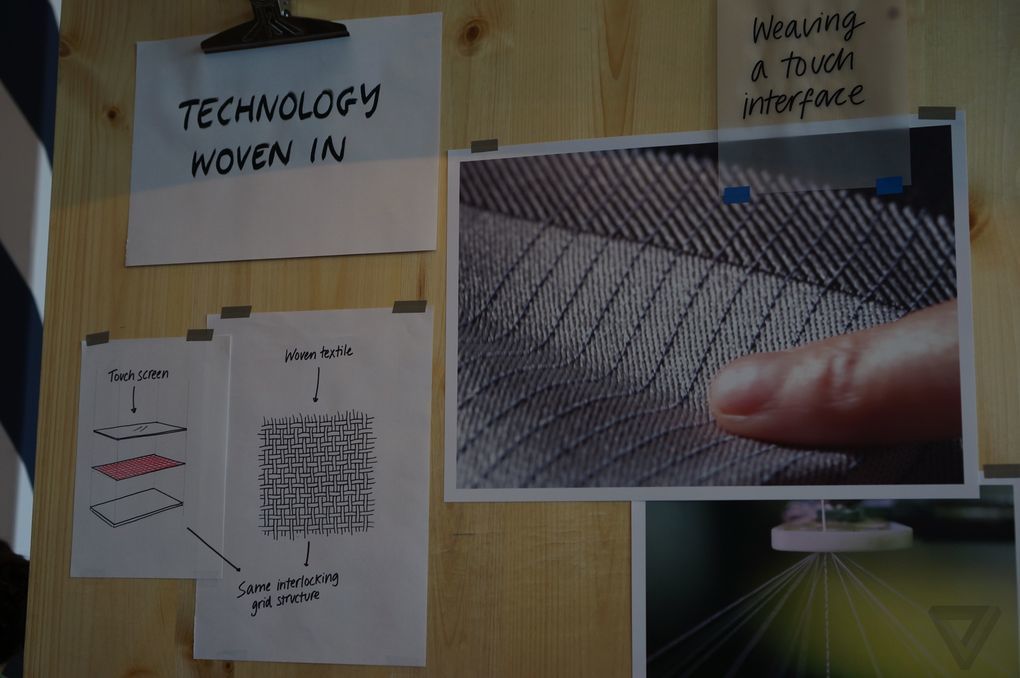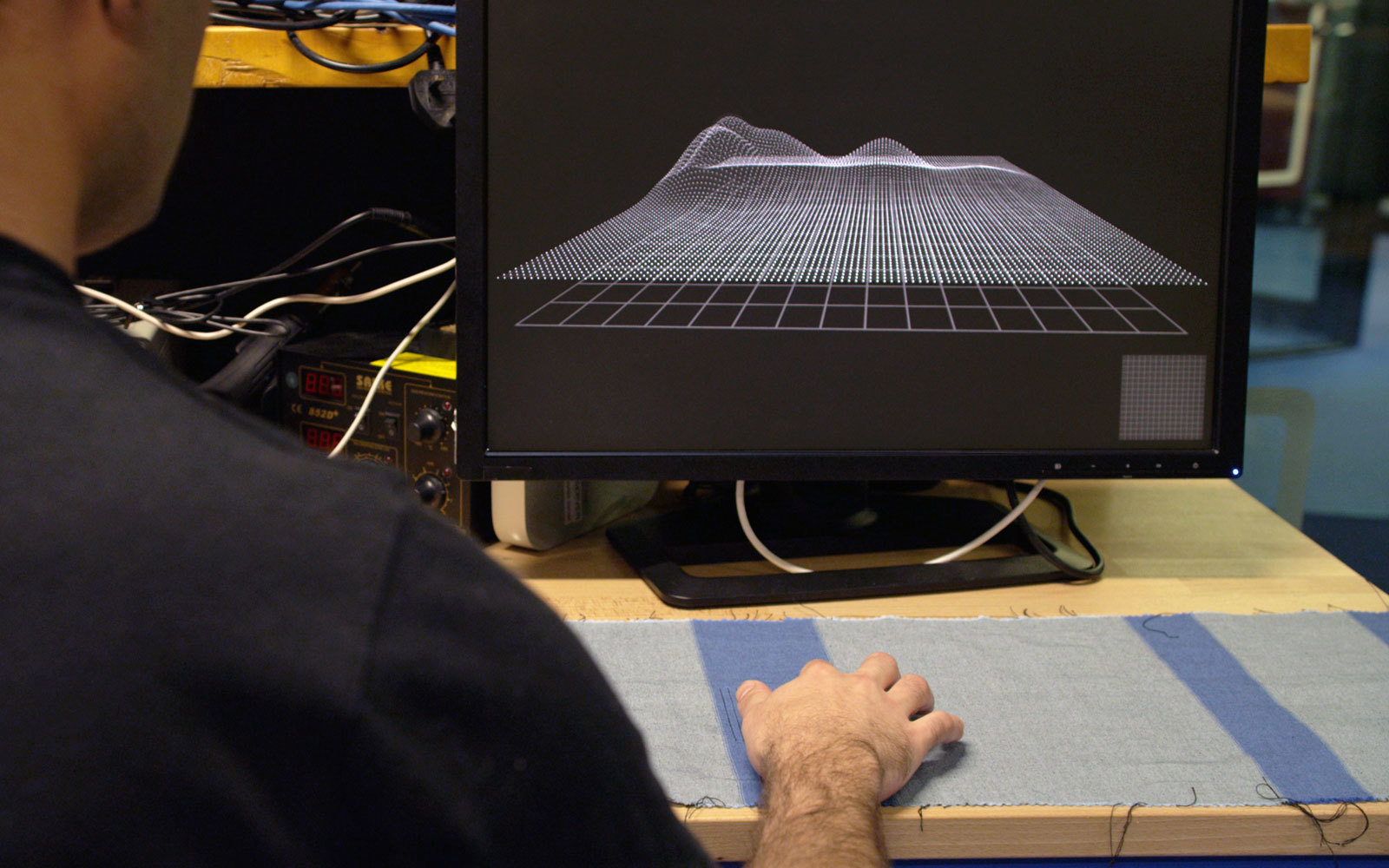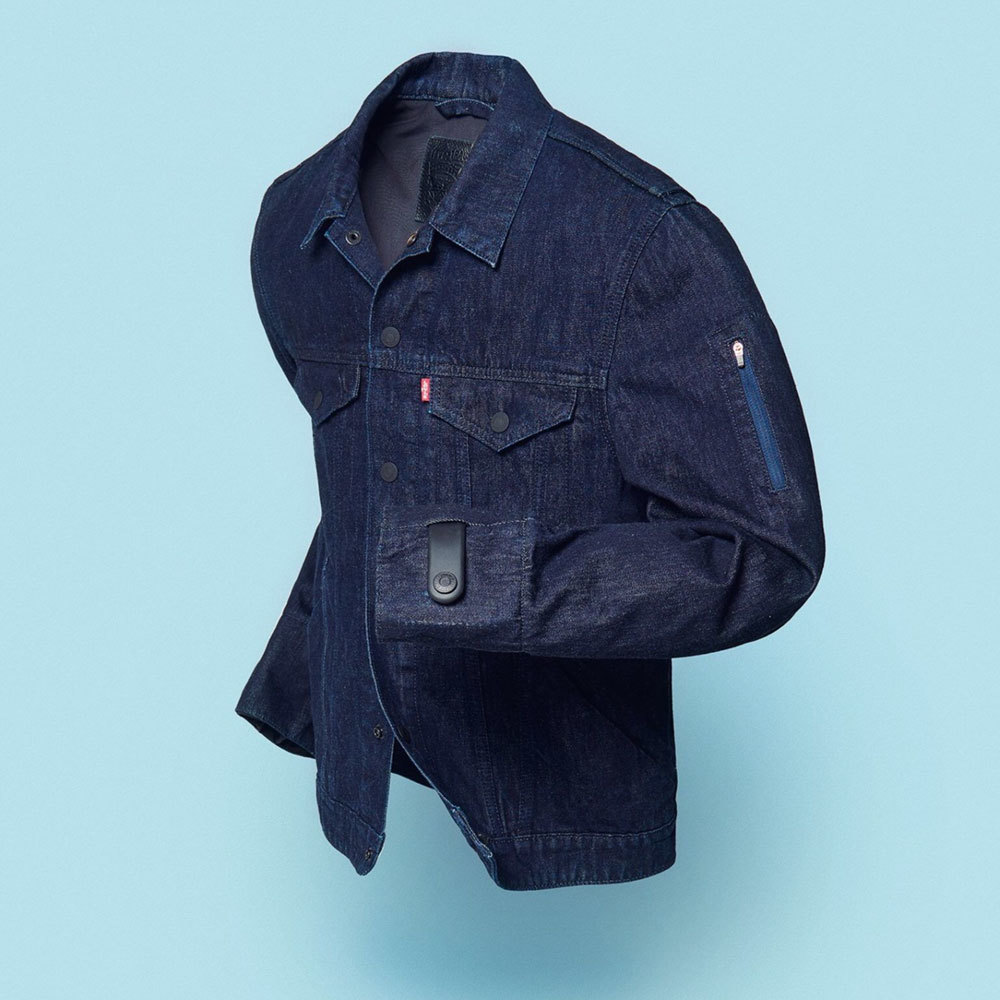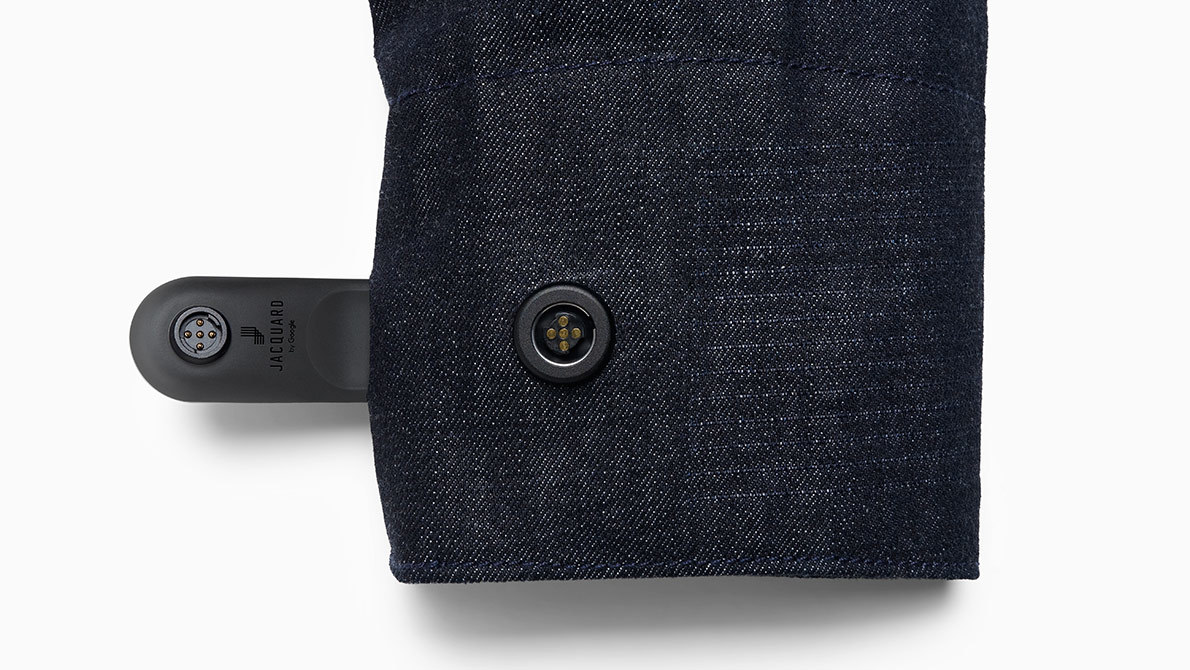How Google makes the world's first smart clothes
In a couple of months, the first smart jacket from Google and Levi's will go on sale. New jeans promise to turn our ideas about clothes: technology will literally be woven into it. She will learn to understand your gestures and help in everyday life, as smart watches and telephones do now. For the project, Jacquard is responsible for a native of Russia, Ivan Pupyrev, and the fabric for smart clothes is sewn in an old Japanese factory with an 80-year-old director who communicates with customers by fax. Banderolka collected all the known details about the new product and Google's Wearable Technology ➙

Touchscreens are not the last step in the evolution of our interaction with gadgets. Google in its incubator technology ATAP has developed two systems that will take the management of electronic devices to a new level. Their code names are Project Soli and Project Jacquard. Both teams of researchers and engineers work under the direction of Ivan Pupyrev , a Russian designer and inventor.
Project Jacquard with Levi's is ready to launch its first product on the market - a denim jacket made of special fabric.through which you can manage your gadgets. It turns out something like a smart watch, but without having to wear them on your wrist. The start of sales is scheduled for the autumn of 2017 (previously, an innovative jacket was promised to be released this spring). Jacquard and Google expect this to be the first commercially successful product released from the ATAP incubator. And, of course, as in any fundamentally new technology, there is a potential here, if not to change the world, then to influence it.
Google spends billions of dollars on new research. Some of them are conducted in the Google X division: there were invented autos with Waymo autopilot, cargo delivery on drones and Google Glass glasses . This department is known for its approach to failed projects. Each such abandoned attempt is considered a success. The team tries first to implement the most complex concepts in order to quickly determine if the project will fail. If it became clear that the project “didn’t take off,” the research team that worked on it is awarded, and a whole holiday is held on this occasion. This is done so that scientists are not afraid of mistakes, and most creatively approached new tasks.

Another piece of technology at Google is being developed by ATAP (Advanced Technology and Projects). Here the conditions for projects are much more severe. It is believed that the entire cycle, from the birth of the idea to the release of the finished product, should last no more than two years. Projects that do not meet deadlines, hack at the root, to give light to more promising concepts. Google adopted this system from DARPA , the research laboratory of the US Department of Defense. Until recently, the department was led by former DARPA director Regina Dugan.

Project Jacquard is the most interesting and promising development of this very ATAP. About what this project team does, you can already understand from the title. The Jacquard Project takes its name from the 1801 Jacquard Machine. In the old days, it was used to make decorative fabrics, but eventually inspired scientists to create the first punched cards for computers. Just as the jacquard has been ahead of its time by almost a hundred years, Project Jacquard is going to look into the future. And this department of Google thinks that the future is connected with IT technologies integrated directly into the fabric of our clothes. Well, the truth is - what's the point of walking in an ordinary jacket, if you can walk in a jacket with smart stuffing ?!

The basis of Jacquard technology is a special fiber, the threads of which are capable of carrying a signal. This fabric is assembled into the same grid as the conductive layer under the touchscreens of the gadgets. As a result, it can track your touches by performing the same functions as the touchpad. On the surface of the fabric, you can swipe and click on it. Moreover, the fabric "feels" in which direction you swipe your finger, and depending on this, the corresponding signal is transmitted to your smartphone (or any other connected device). So you can turn on / off the music, adjust the volume of the sound in the headphones, ask the smartphone about the direction in which you need to move, answer the call and so on.

The conductive filaments developed by the Jacquard project are made from a combination of metal alloys with natural and synthetic yarn (silk, cotton and polyester). They are durable and flexible, you can make clothes of them on almost any industrial loom. From the traditional thread "Jacquard" is almost indistinguishable. It seems that it is just durable, thick denim.
Google believes that Jacquard could become the basis of a new direction - “Wearable Technology”. All our electronics will soon leave the pockets, from which now can easily fall out, or in which it can break if you do not turn around carelessly. Electronics will beclothes. According to Ivan Pupyreva, who heads Project Jacquard, "it is both safer and more convenient." And the clothes that are obtained from the new fabric “can be completely authentic”, i.e. exactly the same as now - fashionable, beautiful and comfortable.

New "smart" clothes - not just a theory. She has already picked up the company Levi's , a manufacturer of iconic jeans. Once this American brand was very fond of Albert Einstein. Levi's leather jacket, which the scientist wore in the 30s, was recently auctioned for $ 120,000. Now Levi's will also promote science to the masses: in its factories, Jacquard fabric will turn into clothing. Levi's experts will also help with the production, design and marketing of smart jackets.
Since Google is traditionally not associated with the release of clothing, the name of the “Corporation of Good” will not appear in the title of the jacket. For the debut of the technology, a time-tested model was chosen, one of the oldest and most popular Levi's jeans . Hence the name - Levi's Commuter Trucker Jacket with Jacquard . It is expected that sales will begin this fall. The cost of the first model of smart clothes will be $ 350. For comparison, the usual Levi's Commuter Trucker Jacket now costs $ 148. That is, for Google-technology we will be asked for an additional two hundred dollars. Is it worth paying more?
The full potential of the technology in the first "device" will not be disclosed. This is more of a test sample - see how the market responds to new clothes. All work with digital technologies is carried out through a cuff link on the left sleeve. It contains electronics that read your gestures and charge. Before washing the cufflink is removed - and the rest of the interactive jacket can be safely put in the washing machine.
The cufflink is charged through the USB port, its appearance resembles a regular button, only bigger and thicker. It is embedded LED, which changes color depending on what operation you performed. Smart clothes will be able to recognize eight different movements. On the one hand, it seems to be a bit, but on the other hand, Jacquard’s functionality will be expanded with the help of several applications, and for them such a set will be quite enough. There are maps, a search engine, and Strava , and Spotify. The creators of the two latest products have been working together with Google for over a year to make a high-quality integration of their services into Jacquard smart clothes. In the presented demo through the jacket it is already possible to receive phone calls, receive information from the GPS about where to go, find out about the sights around you, switch the melody or launch the next playlist. All this - without touching the smartphone.

For now, Google is counting on geeks, collectors (the first smart clothes that can definitely be sold at exorbitant prices in a couple of decades) and cyclists like the jacket more. The last thanks to the smart jacket will not need to be distracted from the road and reach into your pocket to perform any operations. It is enough to take the right hand off the wheel for a second and make one gesture near the left sleeve. Everything is easy and simple. Unless, of course, the technology works as Google promises us.
The creators of the first mass smart-clothes expect that in the coming years, the new technology will “move” into T-shirts, down jackets and pants. From Google, the project is Ivan Pupyrev. Prior to that, the scientist worked at the Sony research center in Tokyo and headed the Disney department, which created eye-displays and other technologies that would increase the realism of cartoons. The Russian’s resume is very impressive, and for the invention of the Touche touch system in 2013, he was even named one of the “One hundred Most Creative People in the Business World”.

In the work on smart clothing, the department that heads Pupyrev faced an unusual obstacle: it turned out that only one small plant in the Japanese mountains could make a conductive fabric with the desired properties. His 80-year-old manager does not even use e-mail and only accepts orders by fax. And now this old factory produces a meter of yarn every two seconds. In the production of consumer electronics from the line every second comes down on a new smartphone or TV. And then - a small piece of thread.
Paul Dillinger, Vice President for Innovation ( Levi's responsible for the smart jacket project ) and Pupyrev, believe that if the public appreciates a revolutionary product, it will be possible to solve the issue of its mass production, and there will be plenty of smart fabrics. From it you can make not only clothes, but also toys, furniture and a bunch of other things useful in the household. It is suitable for seats in cars and on airplanes. And after the success of Levi's jeans, Google’s innovation department plans to start selling technology to other well-known brands.
According to scientists, "wearables" should change the clothing market. In the autumn we will see if they succeed or not. For now, go to Levi’s US Storeand buy yourself some good old jeans - no innovations, but original ones are much cheaper than in Russia. And you will entrust the delivery to the Banderolke - we will quickly deliver your purchases from the USA, we will pack everything in a clever way so that you can save even more. And if you choose something on Amazon and in 5 more American stores, our operators will issue an order for free , redeem the goods and save you time.


Touchscreens are not the last step in the evolution of our interaction with gadgets. Google in its incubator technology ATAP has developed two systems that will take the management of electronic devices to a new level. Their code names are Project Soli and Project Jacquard. Both teams of researchers and engineers work under the direction of Ivan Pupyrev , a Russian designer and inventor.
Project Jacquard with Levi's is ready to launch its first product on the market - a denim jacket made of special fabric.through which you can manage your gadgets. It turns out something like a smart watch, but without having to wear them on your wrist. The start of sales is scheduled for the autumn of 2017 (previously, an innovative jacket was promised to be released this spring). Jacquard and Google expect this to be the first commercially successful product released from the ATAP incubator. And, of course, as in any fundamentally new technology, there is a potential here, if not to change the world, then to influence it.
Jacquard
Google spends billions of dollars on new research. Some of them are conducted in the Google X division: there were invented autos with Waymo autopilot, cargo delivery on drones and Google Glass glasses . This department is known for its approach to failed projects. Each such abandoned attempt is considered a success. The team tries first to implement the most complex concepts in order to quickly determine if the project will fail. If it became clear that the project “didn’t take off,” the research team that worked on it is awarded, and a whole holiday is held on this occasion. This is done so that scientists are not afraid of mistakes, and most creatively approached new tasks.

Another piece of technology at Google is being developed by ATAP (Advanced Technology and Projects). Here the conditions for projects are much more severe. It is believed that the entire cycle, from the birth of the idea to the release of the finished product, should last no more than two years. Projects that do not meet deadlines, hack at the root, to give light to more promising concepts. Google adopted this system from DARPA , the research laboratory of the US Department of Defense. Until recently, the department was led by former DARPA director Regina Dugan.

Project Jacquard is the most interesting and promising development of this very ATAP. About what this project team does, you can already understand from the title. The Jacquard Project takes its name from the 1801 Jacquard Machine. In the old days, it was used to make decorative fabrics, but eventually inspired scientists to create the first punched cards for computers. Just as the jacquard has been ahead of its time by almost a hundred years, Project Jacquard is going to look into the future. And this department of Google thinks that the future is connected with IT technologies integrated directly into the fabric of our clothes. Well, the truth is - what's the point of walking in an ordinary jacket, if you can walk in a jacket with smart stuffing ?!

The basis of Jacquard technology is a special fiber, the threads of which are capable of carrying a signal. This fabric is assembled into the same grid as the conductive layer under the touchscreens of the gadgets. As a result, it can track your touches by performing the same functions as the touchpad. On the surface of the fabric, you can swipe and click on it. Moreover, the fabric "feels" in which direction you swipe your finger, and depending on this, the corresponding signal is transmitted to your smartphone (or any other connected device). So you can turn on / off the music, adjust the volume of the sound in the headphones, ask the smartphone about the direction in which you need to move, answer the call and so on.

The conductive filaments developed by the Jacquard project are made from a combination of metal alloys with natural and synthetic yarn (silk, cotton and polyester). They are durable and flexible, you can make clothes of them on almost any industrial loom. From the traditional thread "Jacquard" is almost indistinguishable. It seems that it is just durable, thick denim.
Google believes that Jacquard could become the basis of a new direction - “Wearable Technology”. All our electronics will soon leave the pockets, from which now can easily fall out, or in which it can break if you do not turn around carelessly. Electronics will beclothes. According to Ivan Pupyreva, who heads Project Jacquard, "it is both safer and more convenient." And the clothes that are obtained from the new fabric “can be completely authentic”, i.e. exactly the same as now - fashionable, beautiful and comfortable.

New "smart" clothes - not just a theory. She has already picked up the company Levi's , a manufacturer of iconic jeans. Once this American brand was very fond of Albert Einstein. Levi's leather jacket, which the scientist wore in the 30s, was recently auctioned for $ 120,000. Now Levi's will also promote science to the masses: in its factories, Jacquard fabric will turn into clothing. Levi's experts will also help with the production, design and marketing of smart jackets.
Since Google is traditionally not associated with the release of clothing, the name of the “Corporation of Good” will not appear in the title of the jacket. For the debut of the technology, a time-tested model was chosen, one of the oldest and most popular Levi's jeans . Hence the name - Levi's Commuter Trucker Jacket with Jacquard . It is expected that sales will begin this fall. The cost of the first model of smart clothes will be $ 350. For comparison, the usual Levi's Commuter Trucker Jacket now costs $ 148. That is, for Google-technology we will be asked for an additional two hundred dollars. Is it worth paying more?
The first smart jeans
The full potential of the technology in the first "device" will not be disclosed. This is more of a test sample - see how the market responds to new clothes. All work with digital technologies is carried out through a cuff link on the left sleeve. It contains electronics that read your gestures and charge. Before washing the cufflink is removed - and the rest of the interactive jacket can be safely put in the washing machine.
The cufflink is charged through the USB port, its appearance resembles a regular button, only bigger and thicker. It is embedded LED, which changes color depending on what operation you performed. Smart clothes will be able to recognize eight different movements. On the one hand, it seems to be a bit, but on the other hand, Jacquard’s functionality will be expanded with the help of several applications, and for them such a set will be quite enough. There are maps, a search engine, and Strava , and Spotify. The creators of the two latest products have been working together with Google for over a year to make a high-quality integration of their services into Jacquard smart clothes. In the presented demo through the jacket it is already possible to receive phone calls, receive information from the GPS about where to go, find out about the sights around you, switch the melody or launch the next playlist. All this - without touching the smartphone.

For now, Google is counting on geeks, collectors (the first smart clothes that can definitely be sold at exorbitant prices in a couple of decades) and cyclists like the jacket more. The last thanks to the smart jacket will not need to be distracted from the road and reach into your pocket to perform any operations. It is enough to take the right hand off the wheel for a second and make one gesture near the left sleeve. Everything is easy and simple. Unless, of course, the technology works as Google promises us.
The creators of the first mass smart-clothes expect that in the coming years, the new technology will “move” into T-shirts, down jackets and pants. From Google, the project is Ivan Pupyrev. Prior to that, the scientist worked at the Sony research center in Tokyo and headed the Disney department, which created eye-displays and other technologies that would increase the realism of cartoons. The Russian’s resume is very impressive, and for the invention of the Touche touch system in 2013, he was even named one of the “One hundred Most Creative People in the Business World”.

Unexpected obstacle
In the work on smart clothing, the department that heads Pupyrev faced an unusual obstacle: it turned out that only one small plant in the Japanese mountains could make a conductive fabric with the desired properties. His 80-year-old manager does not even use e-mail and only accepts orders by fax. And now this old factory produces a meter of yarn every two seconds. In the production of consumer electronics from the line every second comes down on a new smartphone or TV. And then - a small piece of thread.
Paul Dillinger, Vice President for Innovation ( Levi's responsible for the smart jacket project ) and Pupyrev, believe that if the public appreciates a revolutionary product, it will be possible to solve the issue of its mass production, and there will be plenty of smart fabrics. From it you can make not only clothes, but also toys, furniture and a bunch of other things useful in the household. It is suitable for seats in cars and on airplanes. And after the success of Levi's jeans, Google’s innovation department plans to start selling technology to other well-known brands.
According to scientists, "wearables" should change the clothing market. In the autumn we will see if they succeed or not. For now, go to Levi’s US Storeand buy yourself some good old jeans - no innovations, but original ones are much cheaper than in Russia. And you will entrust the delivery to the Banderolke - we will quickly deliver your purchases from the USA, we will pack everything in a clever way so that you can save even more. And if you choose something on Amazon and in 5 more American stores, our operators will issue an order for free , redeem the goods and save you time.

